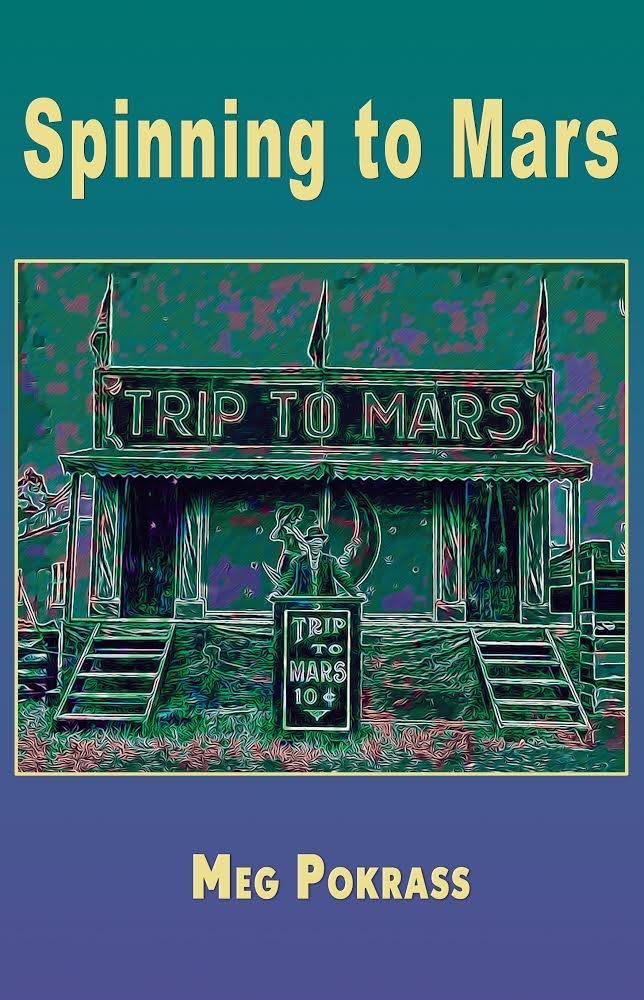With the release of her ninth book, Spinning to Mars (Blue Light Press, 2021), highly prolific and widely acclaimed author Meg Pokrass proves she’s still on top of her game. Fueled by a signature blend of fragility and moxie, Pokrass jettisons her readers upon the rocky terrain of relationships without a parachute. The collection, composed of sixty-seven concisely written microfictions, has no extra ballast to weight it down as Pokrass steers each story along an emotional trajectory that surprises, saddens, and always satisfies. Spinning to Mars is a travelogue of the heart and a wonder of a book.
Pokrass is a two-time winner of San Francisco’s Blue Light Book Award and the author of eight flash fiction collections, two novellas-in-flash, and an award-winning collection of prose poetry. Her work has appeared in over eight hundred literary magazines including Electric Literature, Washington Square Review, American Journal of Poetry, Waxwing, Tupelo Quarterly, and McSweeney’s, has been widely anthologized in places like New Micro (W.W. Norton & Co., 2018), Flash Fiction International (W.W. Norton & Co., 2015), Wigleaf Top 50, and The Best Small Fictions 2018 and 2019. She serves as founding co-editor of Best Microfiction and festival curator of Flash Fiction Festival UK.
I was delighted to talk with Meg about humor, hindsight, hammertoes, and how to properly read a collection of flash fiction.
***
The Rumpus: Meg, what is this book about?
Meg Pokrass: Diane Williams says “The pursuit of intimacy is relatively hopeless in life and is also dangerous.” The book is about the complicated problem of loving.
Rumpus: Yes, your main character seems to understand that her pursuit is futile, yet she continues to seek intimacy and acceptance from her father, her husbands, her boyfriends. She could also be described as an unreliable narrator. Do her inconsistencies in retelling act as a coping mechanism for rejection?
Pokrass: I believe we are all unreliable narrators in our own lives as they are being lived. So, yes. That is really well observed and said.
Rumpus: And we often remember our pasts in fragments. Obvious moments of pain and regret splashed with seemingly mundane events that, in retrospect, have a deeper meaning. Would you agree?
Pokrass: I love how you say this. I am not sure I can say it as well. You pinned what each of the micros is getting at. That there are these seemingly small moments we can only see much later—moments that define our lives in some way and become part of us.
Rumpus: Ah, the power of hindsight. Speaking of which, the title, Spinning to Mars, meant one thing when I started reading and something completely different by the time I was finished. This isn’t a sci-fi collection, so what does Mars represent?
Pokrass: Mars represents the dream of a real home, and of love—no matter how far-fetched and unlikely. “Spinning” to Mars, means we’re always in motion, made dizzy from the gyrations of trying to solve such an essential human need. The problem with both “love” and “home” is that neither of these concepts can be counted on. Homes can fly away in a strong wind. Love is an animal. It has a lifespan of its own, and sometimes, often when we least expect it, it crawls away and dies.
Rumpus: Your work often tackles heavy themes of loneliness, loss, and abandonment, but one of your hallmarks is to balance seriousness with truly laughable moments. I’m thinking specifically of “Hammertoe,” in which the main character not only develops hammertoes like her deceased mother, but learns to connect with her through this inherited pain.
Pokrass: I come from a creative family and have had a topsy-turvy life. My family is notoriously funny about life’s difficulties. I have tried to see it and express it with a comic perspective as a way of getting through it. Humor has been necessary, not optional.
I’m glad some of my stories are funny. I’ll also say that characters who sit around feeling sorry for themselves are not at all interesting to read about. We love to see characters who, despite everything, are finding the light.
Rumpus: This collection is written in a variety of perspectives and tenses. Can you explain the intentions behind this? Also, how did you manage to arrange all sixty-seven stories?
Pokrass: The stories were not, at least consciously, written to fall in any particular order, and were written over many years. The different perspectives they were written in felt right for the stories at the time they were written, and when I put them together, I wondered about changing the various points of view and tenses. Ultimately, I decided not to neaten it up. I realized, through experimentation, that changing these things messed with the integrity of the stories. The stories are really tiny, so perspective is a delicate matter—changes to point of view can make or break a piece. I hope the kaleidoscope effect this creates has added to the surreal quality I was aiming for with the collection.
Ordering stories or chapters in a collection is an intuitive process and a difficult one. I decided on the order for Spinning to Mars by reading the stories aloud and trying them many different ways until they felt right and made up a slanted kind of emotional progression. There is the idea of associative logic and/or dream logic at the helm when I write and when I curate my own work into a collection. The stories aren’t directly connected but feel necessary to the other, so the sound and feel of the pieces that come before and after each story is significant.
Rumpus: This makes me think of a discussion I’ve seen on social media concerning how to properly read a flash fiction collection. Should they be devoured in one sitting, like a large, satisfying meal? Or slowly, bite by bite, like a rich cake?
Pokrass: To me, reading a flash collection feels similar to reading a poetry collection. I really can’t read quickly because they are too intense. When I love a collection, rereading is part of the experience. I’ll hover over just one story for a day or two.
Rumpus: Earlier you touched upon the surrealist feel to these stories. I think part of the dreaminess is due to the length of each piece, some of which are only two or three sentences long. How do you determine where a story starts? Where it ends?
Pokrass: We really have to trust the reader. When a story fulfills itself, it is over. Get in and get out. If you go a few words over that, you’re no longer trusting the reader. In fact, you’re telling them what to think. In terms of where a story begins, the answer is very near the end.
Rumpus: Omission is a hallmark of your work. I love how you give just enough information for the reader to stitch together the longer arch of the book. Can you talk more about omission?
Pokrass: I do feel this is an intuitive part of writing, the art of saying something by not saying it. It’s how the writer chooses to do this that is always so interesting to me. A writer has to know the unsaid thing very well and understand why it is important that it remain silent. I don’t think there is one way to do it. Each writer has to come to it on their own. It thrills me when I read it done well. And, I’m always investigating it in others’ work.
Rumpus: Regarding omission, are you ever concerned that your reader might not “get” your writing?
Pokrass: I work hard to give my stories integrity. I like to think that each reader understands them in slightly different ways, that stories are mood rings.
Rumpus: Stories as mood rings! I love that idea!
Rumpus: You’ve mentioned integrity twice now. What is integrity in writing and why is it so important?
Pokrass: Sanford Meisner, a great acting teacher, said “Acting is behaving truthfully in imaginary circumstances.” It is the same in writing. It’s hard to explain this, but even if the story being told is a character’s extended lie, the reason for the lie itself has to feel truthful. There must be a kind of dramatic urgency invisibly driving each story.
Rumpus: Dramatic urgency! I’m glad you brought this up! Your writing has both a sense of fearlessness and immediacy. I recently learned that early in your career, you suffered a condition that limited your mobility. I keep thinking of Matisse using a long stick to draw on his bedroom walls, of Kahlo painting self-portraits while bedridden. The notion that the work has to come forth, no matter what. Am I hitting upon something here? How has your sickness affected your writing?
Pokrass: When I had reflexive sympathetic dystrophy in my right foot, and couldn’t walk for years, the one thing that distracted me from pain was attending improvisational theater. I would limp into BATS Comedy in San Francisco, a marvelous comedy troupe that has been going for years. It was cheap and it was brilliant. Going to the improv on weekends was one of the chief ways I learned to cope with (and actually alleviate) the nerve pain. When you laugh, you can breathe. Watching spontaneous creativity helped me to write weirdly and wildly, sort of mimicking the feeling I had watching improvisational theater. You have really hit on it here. This is the world’s best question and I don’t know how to do it justice.
Rumpus: Weird and wild! Let’s talk about that. Your writing is fresh and unique, especially your figurative language and sensory details. For instance, you compare teeth to “stacked snow cones.” Your protagonist carves a name into the “shy part of a potato.” This lovely bizarreness is distinctly Meg Pokrass. I suspect that your subconscious plays a large role in your writing process. Am I correct?
Pokrass: Yes, I do think this is true. When I’m writing, it’s like I live in a different place, sort of like a place of dreams. Getting the words out of myself, finding keys to unlock them and coax them out to play… this is my job when I’m writing. I need to do it, even though at times it feels like a chore. It’s really good for me. I would otherwise stay in my shell. I’m an introvert and annoyingly shy. Reinventing ways to break through my silence is what I’m always looking to do. I think the stuff that comes out of me with this huge sense of relief when I am able to find the words. The sensory details pop in unconsciously when I’m writing and they often help to define a piece as I’m writing it. I can follow these details like breadcrumbs to the heart of what’s actually going on.
Our senses are often telling a different story than the one we think is true. Sensory information lives inside the body and tells its own story, and both stories are important; the one we think we are living and the one our bodies are telling us about. The body never lies.
***
Photograph of Meg Pokrass by Meg Pokrass.





